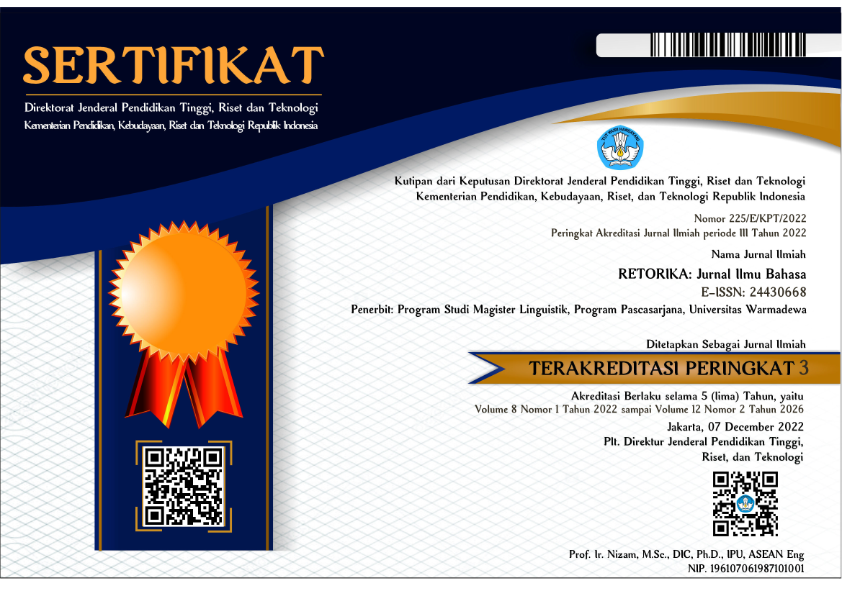An Analysis of Inflectional and Derivational Affixes of the Students’ Academic Writing
Abstract
This study investigates the use of inflectional and derivational affixes in the academic writing of second–year English students, identifying the challenges they face in applying these linguistic elements. Using qualitative methods, specifically content analysis, this study examined a sample of 30 students' writings from the 2021C class. The analysis identified a total of 172 affixes: 122 inflectional suffixes, 36 derivational suffixes, and 14 derivational prefixes. Inflectional suffixes, particularly irregular forms, were predominantly used, while derivational affixes primarily served to change grammatical classes, with "–ly" being the most common. Students encountered several challenges, such as errors in inflectional suffix usage (e.g., omission of plural markers and subject–verb agreement issues) and difficulties with derivational affixes (e.g., omissions and incorrect usage of "–ing," "–ment," "–able," "–re," "–un"). These problems were attributed to confusion between bound and free morphemes, forgetfulness, and a lack of awareness. The study recommends tailored teaching strategies, including targeted exercises, detailed explanations, and ample practice opportunities, to improve students' proficiency with affixes, thereby enhancing the quality and clarity of their academic writing
References
Alfianto, Q. (2014). A Morphological Study of Affixes Found in Campus English Magazine (Skripsi). Universitas Muhammadiyah Surakarta, Surakarta.
Aryati, M. S. (2014). An Analysis of Derivational Affixes in the Land of Five Towers Novel by A. Fuadi Translated by Angie Kilbane (Thesis). Universitas Maria Kudus, Kudus.
Bauer, L. (2012). Beginning Linguistics. New York: Palgrave Macmillan.
Davis, K. A. (1995). Qualitative Theory and Methods in Applied Linguistics Research. TESOL Quarterly, 29(3), 427–453. https://doi.org/https://doi.org/10.2307/3588070
Dewi, R. S. (2014). Teaching Writing Through Dictogloss. Indonesia Journal of English Education, 1(1), 65–76.
Dulay, H., Burt, M., & Krashen, S. (1982). Language Two. New York: Oxford University Press.
Fromkin, V., Rodman, R., & Hyams, N. (2010). An Introduction to Language (9th ed.). California: Wadsworth Cengage Learning.
Gibson, G., Timlin, A., Curran, S., & Wattis, J. (2004). The Scope for Qualitative Methods in Research and Clinical Trials in Dementia. Age and Ageing, 33(4), 422–426. https://doi.org/10.1093/ageing/afh136
Haspelmath, M., & Sims, A. D. (2010). Understanding Morphology (2nd ed.). New York: Routledge. https://doi.org/10.4324/9780203776506
Hien, L. T. T., & Nhan, C. T. M. (2022). EFL Learners’ Perception About Prefixes and Suffixes in English Morphology. European Journal of English Language Teaching, 7(6), 156–170. https://doi.org/10.46827/ejel.v7i6.4605
Jackson, H., & Amvela, E. Z. (2000). Words, Meaning, and Vocabulary: An Introduction to Modern English Lexicology. London: Cintinuum.
Jimmi, & Sulaeman, A. (2022). The Derivational and Inflectional Morpheme in Dwayne Johnson’s Speech: Morphology Perspective. JADEs Journal of Academia in English Educations, 3(2), 97–116.
Jordan, R. R. (1992). Academic Writing Course. London: Nelson.
Josiah, U. E., & Udoudom, J. C. (2012). Morphophonemic Analysis of Inflectional Morphemes in English and Ibibio Nouns: Implications for Linguistic Studies. Journal of Education and Learning, 1(2), 72–81. https://doi.org/10.5539/jel.v1n2p72
Kibiswa, & Naupess, K. (2019). Directed Qualitative Content Analysis (DQlCA): A Tool for Conflict Analysis. The Qualitative Report. https://doi.org/10.46743/2160–3715/2019.3778
Lieber, R. (2021). Introducing Morphology (3rd ed.). New York: Cambridge University Press. https://doi.org/10.1017/9781108957960
O’Grady, W., Dobrovolsky, M., & Aronoff, M. (1997). Contemporary Linguistics: An Introduction (3rd ed.). New York: St. Martin’s Press.
Plag, I. (2018). Word–formation in English. Cambridge: Cambridge University Press.
Puspita, C. (2019). Factors Effecting Students’ Difficulties in Writing Thesis. 3rd English Language and Literature International Conference (ELLiC), 13–22. Semarang: Fakultas Bahasa dan Budaya Asing, Universitas Muhammadiyah Semarang.
Silfia, E. (2014). An Analysis of the Students’ Ability in Writing Exposition Essay by Contrast Development at 11th Year Students of SMAN 3 Sungai Penuh. Penelitian Universitas Jambi Seri Humaniora, 16(2), 15–20.
Todd, L. (1987). An Introduction to Linguistics. Singapore: Longman York Press.
Tosuncuoglu, I. (2017). The Dissection of Affixes on the Words. Professional Studies: Theory and Practice, 3(16), 68–70.
Wagiyo, S. (2021). The Use of Journal Writing in Teaching English Writing. SSRN, 1–20.
Winarni, R. (2016). Pembelajaran Bahasa & Sastra Indonesia Berbasis Linguistik Fungsional Sistemik pada Materi Teks Eksplanasi Buku Siswa Kurikulum 2013 Kelas XI Semester 2. Seminar Nasional Kajian Bahasa Dan Pengajarannya, 759–766. Surakarta: Universitas Muhammadiyah Surakarta.
Zapata, A. A. (2007). Types of Words and Word–Formation Processes in English. Bogotá.
Zsiga, E., Lardiere, D., Kramer, R., Lightfoot, D., Portner, P., Schiffrin, D., … Mani, I. (2014). An Introduction to Language and Linguistics (2nd ed.; R. Fasold & J. C. Linton, Eds.). United Kingdom: Cambridge University Press.
Copyright (c) 2024 RETORIKA: Jurnal Ilmu Bahasa

This work is licensed under a Creative Commons Attribution-ShareAlike 4.0 International License.
This journal provides immediate open access to its content on the principle that making research freely available to the public supports a greater global exchange of knowledge.
All articles published Open Access will be immediately and permanently free for everyone to read and download. We are continuously working with our author communities to select the best choice of license options, currently being defined for this journal as follows: Creative Commons-Non Ceomercial-Attribution-ShareAlike (CC BY-NC-SA)
 Abstract viewed = 29 times
Abstract viewed = 29 times
 PDF downloaded = 24 times
PDF downloaded = 24 times

2.png)














